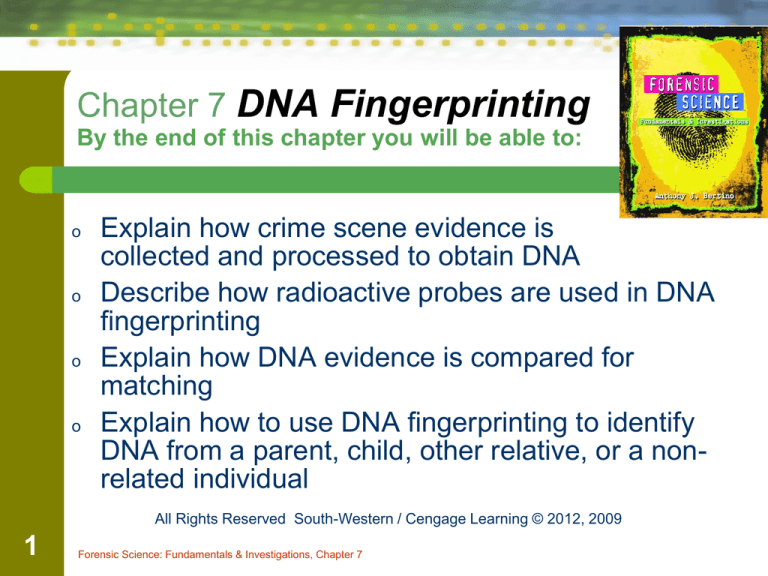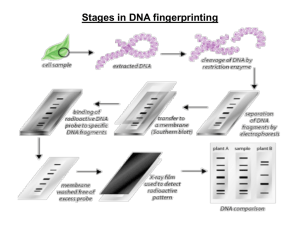
Chapter 7 DNA Fingerprinting
By the end of this chapter you will be able to:
o
o
o
o
Explain how crime scene evidence is
collected and processed to obtain DNA
Describe how radioactive probes are used in DNA
fingerprinting
Explain how DNA evidence is compared for
matching
Explain how to use DNA fingerprinting to identify
DNA from a parent, child, other relative, or a nonrelated individual
All Rights Reserved South-Western / Cengage Learning © 2012, 2009
1
Forensic Science: Fundamentals & Investigations, Chapter 7
History of Biological
Evidence in Forensics
o
DNA fingerprinting
•
•
o
o
2
Also known as DNA profiling
Used with a high degree of accuracy
Biological evidence is examined for the
presence of inherited traits
Some forensics laboratory techniques were
originally developed for other purposes. Can
you name any?
Forensic Science: Fundamentals & Investigations, Chapter 7
The Function
and Structure of DNA
o
o
o
3
DNA contains the genetic material of a cell
Chromosomes are located in the cell
nucleus
Chromosomes contain long DNA strands
wrapped around proteins
Forensic Science: Fundamentals & Investigations, Chapter 7
The Function
and Structure of DNA
o
o
Nitrogenous Bases—pairs of molecules that
form the rungs of the DNA “ladder”
Four types of Bases
•
•
•
•
4
A (adenine)
C (cytosine)
G (guanine)
T (thymine)
Forensic Science: Fundamentals & Investigations, Chapter 7
The Function
and Structure of DNA
o
Base-Pairing Rules
•
•
5
adenine (A) binds only with thymine(T)
Cytosine (C) binds only with guanine (G)
Forensic Science: Fundamentals & Investigations, Chapter 7
DNA Identification
o
o
o
6
Polymorphisms: Non-coded DNA that contain
unique patterns of repeated base sequences
that that are unique to individuals
DNA Fingerprinting (Profiling) isolates and
analyzes polymorphisms
DNA fingerprints appear as a pattern of bands
on X-ray film.
Forensic Science: Fundamentals & Investigations, Chapter 7
DNA Profile
Two types of repeating DNA sequences
o
Variable Numbers of Tandem Repeats (VNTR)
•
•
o
Short Tandem Repeats (STR)
•
•
o
2 to 5 bases in length
Shorter lengths make STRs easier to use than VNTRs
VNTR and STR data are analyzed for
•
•
7
The number of repeats varies from person to person
9 to 80 bases in length
tissue matching
inheritance matching
Forensic Science: Fundamentals & Investigations, Chapter 7
DNA Profile Matching
o
Tissue Matching
•
o
Inheritance Matching
•
8
Two samples that have the same band pattern
are from the same person
Each band in a child’s NDA fingerprint must be
present in at least one parent
Forensic Science: Fundamentals & Investigations, Chapter 7
DNA Population Databases
o
Population genetics:
•
•
o
Examples
•
•
9
the study of gene variations among groups of
individuals
Analyze the probability of a random person with
the same alternative form of a gene (an allele)
Identifying the suspect in a crime
Identifying an alleged father in a paternity case
Forensic Science: Fundamentals & Investigations, Chapter 7
Sources of DNA
o
o
o
o
10
Biological evidence: examples include saliva,
blood, skin, hair, seminal fluid
Individual evidence is capable of identifying a
specific person.
Small amounts may be only trace evidence
Polymerase chain reaction (PCR) technique
generates multiple copies of DNA evidence
Forensic Science: Fundamentals & Investigations, Chapter 7
Collection and
Preservation of DNA
1. Use disposable gloves and collection
2.
3.
4.
5.
11
instruments
Avoid physical contact, talking, sneezing, and
coughing in the evidence area
Air-dry evidence and put it into new paper bags
or envelopes
Dry or freeze the evidence
Keep evidence cool and dry during
transportation and storage
Forensic Science: Fundamentals & Investigations, Chapter 7
Preparing DNA Samples
for Fingerprinting
1. DNA is mixed with special enzymes
2. Enzymes cut apart the DNA in specific
places forming different sized fragments
3. DNA is separated within an agarose gel
4. An electric current is passed through the gel
separating the fragments by size
12
Forensic Science: Fundamentals & Investigations, Chapter 7
Preparing DNA Samples
for Fingerprinting
Extraction
1. Cells are isolated from biological evidence such
as blood, saliva, urine, semen, and hair
2. The cells are disrupted to release the DNA
from proteins and other cell components
3. The DNA can be extracted from the cell
nucleus
13
Forensic Science: Fundamentals & Investigations, Chapter 7
Preparing DNA Samples
for Fingerprinting
Amplification
o
o
14
VNTR analyses—polymerase chain reaction
(PCR) can be used to amplify the DNA that
contains the VNTRs
STR profiles—restriction enzymes are
unnecessary; PCR allows the amplification of the
strands with STR sequences
Forensic Science: Fundamentals & Investigations, Chapter 7
Preparing DNA Samples
for Fingerprinting
Electrophoresis
15
o
DNA samples are placed in gels through which
electronic currents are passed
o
DNA fragments line up in bands along the length of
each gel
Forensic Science: Fundamentals & Investigations, Chapter 7
Electrophoresis
o
o
16
An electrophoresis
apparatus running five
sample of DNA
Arrows show the movement
of the negatively charged
DNA fragments through the
gel matrix
Forensic Science: Fundamentals & Investigations, Chapter 7
Probes
o
DNA probes
•
•
•
o
17
identify the unique sequences in a person’s DNA
are made up of different synthetic sequences of
DNA bases complimentary to the DNA strand
bind to complimentary bases in the strand (see the
fragmentary DNA bands above)
In most criminal cases, 6 to 8 probes are used
Forensic Science: Fundamentals & Investigations, Chapter 7
Analysis of DNA
Fingerprints and Applications
Bands and widths are significant in
matching samples of DNA
18
Forensic Science: Fundamentals & Investigations, Chapter 7
Analysis of DNA
Fingerprints and Applications
o
DNA fingerprinting can
• match crime scene DNA with a suspect
• determine maternity, paternity, or match to another
relative
• eliminate a suspect
• free a falsely imprisoned individual
• identify human remains
19
Forensic Science: Fundamentals & Investigations, Chapter 7
. . . . . . . . . . . . . . Summary . . . .
o
o
o
o
20
DNA contains the information needed for replication in
a sequence of nitrogenous bases.
DNA analysis allows even a small sample of tissue to
be identified with a single individual.
DNA contains, in non-coding regions called junk DNA,
many repeated sequences that vary in number
between individuals.
These differences between individuals can be used to
produce a DNA fingerprint for an individual.
Forensic Science: Fundamentals & Investigations, Chapter 7
. . . . . . . . . . . . . . . . . Summary
o
o
o
o
21
Polymerase chain reaction (PCR) for DNA
amplification has largely eliminated the problem
resulting from the tiny samples usually available.
DNA evidence must be collected carefully to avoid
contamination with other DNA.
DNA analysis involves extraction, electrophoresis, and
visualization.
DNA profiles are kept by police agencies in electronic
databases.
Forensic Science: Fundamentals & Investigations, Chapter 7








